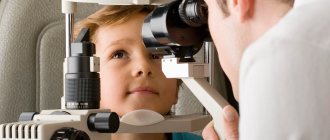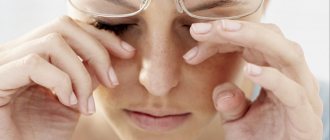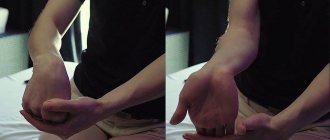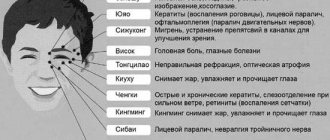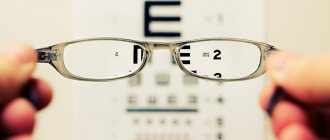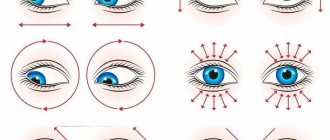The problem of decreased visual acuity in the population is one of the main problems in medicine today. Experts say that myopia and farsightedness are reaching epidemic proportions. But these diseases can be treated with both conservative and surgical methods. Separately, it is worth considering such a method of restoring vision as eye gymnastics according to Avetisov. This technique has received worldwide recognition. It was originally created to be used for the treatment and prevention of childhood strabismus and myopia. But later it was found that regular exercise helped improve the condition of the visual system.
Why does vision deteriorate?
Vision is responsible for a person’s ability to receive up to 90% of information about the environment. We need it for work, study, recreation - in general, in all areas of life. However, a person who actively uses his eyes does not think about the fact that they also need training and rest, like all other organs of the body. Due to careless handling and lack of care for the eyes, vision begins to “shrink”, and often quite quickly. There are also a number of other reasons why a person begins to see worse.
The main causes of visual impairment:
| Cause | Explanation |
| Lack of proper load on the eye muscles | The ability to see from a physiological point of view is due to the presence of a retina and a lens in the eye. The latter is a special lens, which special muscles force to change shape, bend, make it either more convex or flat. This depends on the distance at which the object in question is located. Thus, if a person constantly looks at the same objects (for example, focusing only on a book or computer), then part of the muscles that control the curvature of the lens weaken and lose tone. |
| Poor circulation | The body's cells are supplied by blood circulating through the blood vessels. The retina reacts especially acutely to a lack of blood. That is why it is important to monitor the condition of the circulatory system. |
| Age-related changes | The retina, like any other part of the body, begins to age over time. It contains a light-sensitive pigment that begins to deteriorate as the body ages. Vitamin A, which must be obtained in the right quantities along with food, will help slow down the destruction process. It is especially beneficial to eat a lot of carrots and blueberries. |
| Eye strain | Excess or lack of light has a detrimental effect on the condition of the retina. Therefore, you need to provide good light in the work area, and protect your eyes from the bright sun outside. |
| Overdrying of the mucous membrane | The eye is constantly bathed in a special fluid produced by the eye. If it is not enough, then visual acuity will decrease. |
Some of the reasons described, fortunately, can be eliminated if you take care of your eye health and constantly train them. A special gymnastics developed by Eduard Avetisov will help you do this.
Gymnastics for the eyes: third group
These exercises are aimed at improving and training accommodation. Unlike the previous two, they need to be performed standing:
- Extend your arm in front of your nose about 30 cm with your thumb raised. Look straight ahead for 2-3 seconds, and then move your eyes to your finger. After 5 seconds, look forward again, then back to your finger. You should do 9-12 such alternations.
- Extend your arm and fix your gaze on the raised thumb. Then begin to slowly bring it closer to your nose, stopping at the moment when your finger begins to see double. Repeat 7-8 times.
- For this exercise you will need to wear glasses or contacts if you wear them. Stick a bright mark on the window in the form of a circle with a diameter of 3-5 mm. Then find an object behind the glass that passes through this mark. Stop your gaze on it, and then move it to a distant object and again to the mark, pausing for 3-5 seconds each time. Do the exercise for each eye separately and for both for five to seven minutes.
We see that eye gymnastics according to Avetisov’s method includes a set of various exercises aimed at strengthening the optical system. Please note that they are only preventive in nature and are not capable of completely correcting myopia. However, regular implementation of this complex shows effective results. If the child already has a degree of myopia of more than +3 diopters, then classes according to the Bates system, aimed at relieving tension in the eye muscles, are suitable for him.
Who is Avetisov
Eduard Sergeevich Avetisov was an experienced professor in the field of ophthalmology, his name is known throughout the world. He studied eye diseases, as well as the prevention and treatment of these diseases. He made a very great contribution to the development of domestic medicine in the field of ophthalmology, was devoted to science, had excellent performance indicators and spent a lot of energy on research.
Eduard Sergeevich Avetisov
Avetisov Eduard Sergeevich was born in Samarkand, graduated from medical institute there and began working at the department of treatment of eye diseases. For a long time he worked at the Research Institute of Eye Diseases named after. Helmholtz - here his experience was more than 40 years, and for 35 years Eduard Sergeevich personally supervised all scientific work of the university and carried out a lot of research. At the same time, he managed to manage the department of children's vision protection and laboratories. Eduard Avetisov was engaged in all kinds of research in the field of vision, studied the problems of myopia and hyperopia, optical nystagmus, etc. By developing these areas, it was possible to obtain a classification of amblyopia, develop the latest and most relevant treatment methods, including gymnastics, which helped improve the vision of thousands of people .
Avetisov, together with his employees, was engaged in a very serious and important matter - protecting the vision of children and adolescents
Correction of low vision is the main problem that Avetisov dealt with. He, in collaboration with his colleagues, was able to develop a new system for restoring and improving vision functions with nystagmus, and put forward a theory of the pathogenesis of myopia, which was eventually confirmed by other scientists.
It was thanks to Eduard Avetisov that the Ministry of Health approved a new medical position - pediatric ophthalmologist. This professor was able to develop special eye gymnastics that helps develop and actively train small eye muscles and maintain the health of the visual organs. Now this gymnastics is wildly popular.
Zinaida, 48 years old: “I started having problems with my eyes at the age of 40. Visual acuity fell very quickly. I started wearing glasses. And I even tuned in for laser correction. On the advice of an ophthalmologist, I tried to perform gymnastics according to Avetisov. Of course, after several sessions I didn’t notice any effect at first. But she continued her training. And so, I began to notice that my vision had improved a little, and my eyes began to not get so tired when working with the computer. So there really is an effect from gymnastics!”
Second block
This complex is also performed while sitting. To achieve the desired result, you need to maintain the starting position and avoid unnecessary movements. Gymnastics according to Avetisov for the eyes is repeated eight or ten times.
- Look at the ceiling and then slowly lower your gaze down. Take your time - eye movements should be smooth.
- Look at the selected point on the left, and then at the left. Please note that when performing this task you should sit still and not turn your head.
- Move your gaze diagonally from the top corner of the room to the bottom.
- Imagine that there is a large circle in front of you and begin to glance across it, first in one direction and then in the other.
Regularly performing this task will strengthen the motor muscles of the eye.
Features of the technique
Eduard Avetisov always said that the sooner a person begins to take care of his eyes and engage in the prevention of myopia and other diseases, the greater the chance of not having problems with the quality of vision in his life. The gymnastics developed by the scientist are precisely aimed at training the eyes and preventing many diseases.
The emphasis in the technique is on adapting the eyes to various changes that occur as a result of objects moving at different distances. The program is designed to be repeated daily. In general, gymnastics involves several types of eye movements that help train and develop a function called “accommodation.” Avetisov advised doing the exercises during the day, during lunch breaks at work, to relax your eyes and relieve tension.
The sooner a person starts doing such gymnastics, the better. Avetisov especially recommended his method to children - those who performed such tasks from childhood had a minimum of vision problems at an older age. However, gymnastics is also suitable for adults, as well as for lovers of reading and those who work a lot at the computer.
Advantages of Avetisov gymnastics:
- short duration of exercises - it is enough to spend only 15-20 minutes a day on eye training;
- good prevention of eye diseases;
- the ability to cope with a number of pathologies without drug treatment;
- the ability to perform gymnastics anywhere - at home, at work, on the street, in transport, etc.;
- ease of performing exercises - you do not need to have special skills or any specialized equipment;
- This type of gymnastics improves concentration.
Valeria, 24 years old: “My daughter and I have been doing Avetisov gymnastics since she was 4 years old, when the doctor first told us that her visual acuity had dropped a little. Her ophthalmologist advised us so that her pathology would not progress in the future. For a child, this is a kind of game - she likes to sit down with me and do these simple exercises. It’s both fun and useful. The baby doesn’t complain about her eyes.”
Types of myopia
In this article
- Types of myopia
- Basic methods of treating myopia
- The meaning of accommodation
- Exercises for myopia according to Avetisov - features
- First set of exercises
- The second complex of visual gymnastics by Avetisov
- Third complex
A visual impairment in which a person has difficulty seeing distant objects is called myopia. Such a pathology can be congenital, for example, due to disorders that arose during intrauterine development, abnormalities of the cornea, lens, eyeball, etc. In this case, the child has a high degree of myopia. If a person has a genetic predisposition to myopia (weakness of the sclera, defective ciliary muscle), then myopia can be acquired and develop under unfavorable conditions: decreased immunity, infectious and chronic diseases, excessive visual stress.
In addition to anatomical myopia, there is also accommodative myopia. It is accommodative myopia that often causes visual impairment in true myopia. In order for myopia treatment methods to be effective, detailed diagnosis is necessary. Relieving a spasm of accommodation, if it is detected in a timely manner, is quite simple - you need to regularly perform a set of useful exercises that strengthen the ciliary muscle, choosing the appropriate author’s method for restoring vision, for example, exercises according to Avetisov. It is better if the exercises are performed in conjunction with other therapeutic measures.
Gymnastics according to Avetisov
All gymnastics exercises according to Avetisov can be divided into three groups. They need to be performed without overexertion, at a comfortable pace, which can be increased over time. At first, each task is performed about 4-5 times, gradually the number of repetitions should increase to 8-12 per workout. In general, gymnastics according to Avetisov does not take much time.
Group 1
The tasks included in the first group of Avetisov’s gymnastics are aimed at improving the functioning of the blood supply system to the visual apparatus and stimulating the circulation of lacrimal and other fluids inside the eye. They need to be performed only while sitting and completely relaxed.
Step 1. Each eye in turn is tightly closed and held in the closed position for about 3-5 seconds. The open position is also maintained for about 3-5 seconds.
Step 2. Blink your eyelids quickly for a short period of time - up to 10-15 seconds. Next, a 7-10 second pause is made.
Step 3. Lightly massage the eyeball, which is closed by the eyelids, with your finger (it’s most convenient to do this with your index finger). Move your finger in circles, massage one eye for 1 minute.
Step 4. Both eyeballs are closed, and with three fingers of both hands pressure is applied to each of them. Duration – no more than 1-3 s.
Step 5. Both eyes are covered with eyelids, and the skin in the area of the superciliary arch is pressed with your fingers. At this time, your fingers should provide slight resistance to the movement of the muscles of the forehead and eyelids.
Group 2
This group of tasks is performed in a sitting position, and the person’s head must remain motionless at this time. Gymnastics strengthens the eye muscles.
Step 1. The gaze of the eyes is calmly and slowly directed to the ceiling, and then just as slowly moved down to the floor.
Step 2. The gaze is directed to the left, and then to the right, after which - vice versa.
Step 3. The gaze is directed along the diagonals of an imaginary rectangle in which the eyes are inscribed.
Step 4. Imagine an imaginary clock face. The gaze circles him clockwise, and then counterclockwise.
Zoryana, 27 years old: “I’ve heard about Avetisova’s gymnastics for a long time. I'm nearsighted. And if at first it didn’t bother me at all, since the deviations were insignificant, now I began to see worse. I don’t want to wear glasses or contact lenses, nor do I want to have laser correction. I decided to try the popular Avetisov gymnastics. And I’m more than satisfied with the result. My vision has almost returned to normal, and this is taking into account the fact that I exercise every day, but not so long ago. So for those who are still thinking about whether to do the exercises or not, I will say only one thing - be sure to try it.”
First set of exercises
You can do eye exercises at home, during breaks at work, dedicating at least 10-15 minutes to the exercises. The results will be noticeable in a few days: vision will become clearer, and your eyes will not be very tired.
The exercises are performed in the following sequence:
- Warm up your eyelids with light massage movements, and then strongly squeeze and unclench them 7-8 times, pausing for three seconds (you need to do several approaches, at least 6) - this will improve blood circulation in the eyes.
- Blink both eyes quickly at the same time for 10-15 seconds, repeat the exercise.
- Massage the eyeball through closed eyelids - you need to apply light pressure on the eyes for a couple of seconds, repeat the exercise two to three times.
- Massage the brow ridges with the tips of your index fingers.
What preventative and treatment measures are needed in addition to gymnastics?
First of all, gymnastics is aimed at preventing vision impairment. Other treatment measures should complement and enhance the effect, especially if the disease has already occurred and exercises alone cannot be done.
If disorders are associated with the shape of the eyeball, then wearing glasses is the most traditional method of treatment.
Depending on the severity of the impairment, glasses may only be prescribed when a certain type of work is being performed, such as reading. If possible, glasses can be replaced with contact lenses.
If minor impairments are detected in a child and preventive exercises are performed daily, a number of other rules should also be followed that will help preserve vision. Make sure your child's work area is well lit.
Choose furniture that will maintain correct posture. Monitor your time sitting at the computer and playing video games. Give your eyes a break from concentrating.
Indications and contraindications according to the professor's system
Gymnastics for the eyes is considered useful and effective. Despite all the benefits of exercise, there are diseases in which doing exercises will only worsen your vision.
Indications for exercises:
- Gymnastics relaxes the eyes after exertion and assimilation of a large amount of information. This applies mainly to schoolchildren and students who spend time at the computer or reading books in search of information.
- During the exercises, the eyes relax.
- The appearance of burning and redness indicates drying of the mucous membrane of the eye. During gymnastics, it begins to function normally again and the discomfort disappears.
- Vision improves due to good blood circulation. Exercise stimulates blood flow, thereby promoting improvements.
- Daily gymnastics stimulates the eye muscles, oxygen supply, and mucosal function. All properly functioning functions prevent vision loss even during daily work at the computer.
Contraindications to exercises:
- In case of retinal detachment, strengthening the work of blood vessels due to gymnastics can provoke decreased vision.
- When a person is sick with inflammatory eye diseases, such as conjunctivitis, there is an infection in the mucus, which can be transferred to other parts of the face with the help of exercises.
- After surgery, you should not stimulate blood flow. This may cause the stitches to come apart and cause bleeding. During rehabilitation, you should give up gymnastics.



